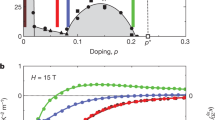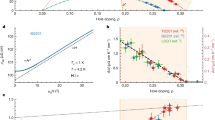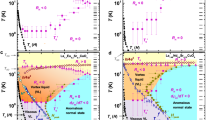Abstract
Efforts to understand the microscopic origin of superconductivity in the cuprates are dependent on knowledge of the normal state. The Hall number in the low-temperature, high-field limit nH(0) has a particular importance because, within conventional transport theory, it is simply related to the number of charge carriers, so its evolution with doping gives crucial information about the nature of the charge transport. Here we report a study of the high-field Hall coefficient of the single-layer cuprates Tl2Ba2CuO6+δ (Tl2201) and (Pb/La)-doped Bi2Sr2CuO6+δ (Bi2201), which shows how nH(0) evolves in the overdoped—so-called strange metal—regime of cuprates. We find that nH(0) increases smoothly from p to 1 + p, where p is the number of holes doped into the parent insulating state, over a wide range of doping. The evolution of nH correlates with the emergence of the anomalous linear-in-temperature term in the low-temperature in-plane resistivity. The results could suggest that quasiparticle decoherence extends to dopings well beyond the pseudogap regime.
This is a preview of subscription content, access via your institution
Access options
Access Nature and 54 other Nature Portfolio journals
Get Nature+, our best-value online-access subscription
$29.99 / 30 days
cancel any time
Subscribe to this journal
Receive 12 print issues and online access
$209.00 per year
only $17.42 per issue
Buy this article
- Purchase on Springer Link
- Instant access to full article PDF
Prices may be subject to local taxes which are calculated during checkout



Similar content being viewed by others
Data availability
The data that support the plots within this paper and other findings of this study are available from the corresponding author upon reasonable request.
References
Keimer, B., Kivelson, S. A., Norman, M. R., Uchida, S. & Zaanen, J. From quantum matter to high-temperature superconductivity in copper oxides. Nature 518, 179–186 (2015).
LeBoeuf, D. et al. Electron pockets in the Fermi surface of hole-doped high-Tc superconductors. Nature 450, 533–536 (2007).
Sebastian, S. E., Harrison, N. & Lonzarich, G. G. Towards resolution of the Fermi surface in underdoped high-Tc superconductors. Rep. Prog. Phys. 75, 102501 (2012).
Vignolle, B. et al. Quantum oscillations in an overdoped high-Tc superconductor. Nature 455, 952–955 (2008).
Bangura, A. F. et al. Fermi surface and electronic homogeneity of the overdoped cuprate superconductor Tl2Ba2CuO6 + δ as revealed by quantum oscillations. Phys. Rev. B 82, 140501 (2010).
Rourke, P. M. C. et al. A detailed de Haas-van Alphen effect study of the overdoped cuprate Tl2Ba2CuO6 + δ. New J. Phys. 12, 105009 (2010).
Hussey, N. E., Abdel-Jawad, M., Carrington, A., Mackenzie, A. P. & Balicas, L. A coherent three-dimensional Fermi surface in a high-transition-temperature superconductor. Nature 425, 814–817 (2003).
Plate, M. et al. Fermi surface and quasiparticle excitations ofoverdoped Tl2Ba2CuO6 + δ. Phys. Rev. Lett. 95, 077001 (2005).
Kubo, Y., Shimakawa, Y., Manako, T. & Igarashi, H. Transport and magnetic-properties of Tl2Ba2CuO6 + δ showing a delta-dependent gradual transitionfrom an 85-K superconductor to a nonsuperconducting metal. Phys. Rev. B 43, 7875–7882 (1991).
Manako, T., Kubo, Y. & Shimakawa, Y. Transport and structural study of Tl2Ba2CuO6 + δ single-crystals prepared by the KCl flux method. Phys. Rev. B 46, 11019–11024 (1992).
Hussey, N. E. Phenomenology of the normal state in-plane transport properties of high-Tc cuprates. J. Phys. Condens. Matter 20, 123201 (2008).
Hussey, N. E., Gordon-Moys, H., Kokalj, J. & McKenzie, R. H. Generic strange-metal behaviour of overdoped cuprates. J. Phys. Conf. Ser. 449, 012004 (2013).
Shibauchi, T., Carrington, A. & Matsuda, Y. A quantum critical point lying beneath the superconducting dome in iron pnictides. Annu. Rev. Condens. Matter Phys. 5, 113–135 (2014).
Taillefer, L. Scattering and pairing in cuprate superconductors. Annu. Rev. Condens. Matter Phys. 1, 51–80 (2010).
Blanco-Canosa, S. et al. Resonant X-ray scattering study of charge-density wavecorrelations in YBa2Cu3O6 + x. Phys. Rev. B 90, 054513 (2014).
Tabis, W. et al. Synchrotron X-ray scattering study ofcharge-density-wave order in HgBa2CuO4 + δ. Phys. Rev. B 96, 134510 (2017).
Cooper, J. R., Loram, J. W., Kokanovic, I., Storey, J. G. & Tallon, J. L. Pseudogap in YBa2Cu3O6 + δ is not bounded by a line of phase transitions: thermodynamic evidence. Phys. Rev. B 89, 201104 (2014).
Ramshaw, B. J. et al. Quasiparticle mass enhancement approaching optimal doping in a high-Tc superconductor. Science 348, 317–320 (2015).
Badoux, S. et al. Change of carrier density at the pseudogap critical point of a cuprate superconductor. Nature 531, 210–214 (2016).
Putzke, C. et al. Inverse correlation between quasiparticle mass and Tc in a cuprate high-Tc superconductor. Sci. Adv. 2, e1501657 (2016).
Ando, Y., Kurita, Y., Komiya, S., Ono, S. & Segawa, K. Evolution of the Hall coefficient and the peculiar electronic structure of the cuprate superconductors. Phys. Rev. Lett. 92, 197001 (2004).
Balakirev, F. F. et al. Quantum phase transition in the magnetic-field-induced normal state of optimum-doped high-Tc cuprate superconductors at low temperatures. Phys. Rev. Lett. 102, 017004 (2009).
Horio, M. et al. Three-dimensional Fermi surface of overdoped La-based cuprates. Phys. Rev. Lett. 121, 077004 (2018).
Collignon, C. et al. Fermi-surface transformation across the pseudogap critical point of the cuprate superconductor La1.6 − xNd0.4SrxCuO4. Phys. Rev. B 95, 224517 (2017).
Matt, C. E. et al. Electron scattering, charge order, and pseudogap physics in La1.6 − xNd0.4SrxCuO4: an angle-resolved photoemission spectroscopy study. Phys. Rev. B 92, 134524 (2015).
Ding, Y. et al. Disappearance of superconductivity and a concomitant Lifshitz transition in heavily overdoped Bi2Sr2CuO6 superconductor revealed by angle-resolved photoemission spectroscopy. Chin. Phys. Lett. 36, 017402 (2019).
Abdel-Jawad, M. et al. Anisotropic scattering and anomalous normal-state transport in a high-temperature superconductor. Nat. Phys. 2, 821–825 (2006).
Abdel-Jawad, M. et al. Correlation between the superconducting transitiontemperature and anisotropic quasiparticle scattering in Tl2Ba2CuO6 + δ.Phys. Rev. Lett. 99, 107002 (2007).
Kondo, T., Takeuchi, T., Kaminski, A., Tsuda, Y. & Shin, S. Evidence for two energy scales in the superconducting state of optimally doped (Bi,Pb)2(Sr,La)2CuO6 + δ. Phys. Rev. Lett. 98, 267004 (2007).
Wise, W. D. et al. Charge-density-wave origin of cuprate checkerboard visualized by scanning tunnelling microscopy. Nat. Phys. 4, 696–699 (2008).
Wise, W. D. et al. Imaging nanoscale Fermi-surface variations in an inhomogeneous superconductor. Nat. Phys. 5, 213–216 (2009).
Kondo, T., Khasanov, R., Takeuchi, T., Schmalian, J. & Kaminski, A. Competition between the pseudogap and superconductivity in the high-Tc copper oxides. Nature 457, 296–300 (2009).
French, M. M. J., Analytis, J. G., Carrington, A., Balicas, L. & Hussey, N. E. Tracking anisotropic scattering in overdoped Tl2Ba2CuO6 + δ above 100 K. New J. Phys. 11, 055057 (2009).
Balakirev, F. et al. Signature of optimal doping in Hall-effect measurements on a high-temperature superconductor. Nature 424, 912–915 (2003).
Pelc, D., Popčević, P., Požek, M., Greven, M. & Barišić, N. Unusual behavior of cuprates explained by heterogeneous charge localization. Sci. Adv. 5, eaau4538 (2019).
Tallon, J. M. & Loram, J. W. The doping dependence of T*—what is the real high-Tc phase diagram. Physica C 349, 53–68 (2001).
Wade, J. M., Loram, J. W., Mirza, K. A., Cooper, J. R. & Tallon, J. L. Electronic specific-heat of Tl2Ba2CuO6 + δ from 2 K to 300 K for 0 ≥ δ ≥ 0.1. J. Supercond. 7, 261–264 (1994).
Fujiwara, K. et al. 63Cu knight shift study in high-Tc superconductor Tl2Ba2CuO6 + y with a single CuO2 layer. J. Phys. Soc. Jpn 59, 3459–3462 (1990).
Kambe, S., Yasuoka, H., Hayashi, A. & Ueda, Y. NMR study of the spin dynamics in Tl2Ba2CuOy (Tc = 85 K). Phys. Rev. B 47, 2825–2834 (1993).
Kawasaki, S., Lin, C. T., Kuhns, P. L., Reyes, A. P. & Zheng, G.-Q. Carrier-concentration dependence of the pseudogap ground state of superconducting Bi2Sr2 − xLaxCuO6 + δ revealed by 63,65Cu-nuclear magnetic resonance in very high magnetic fields. Phys. Rev. Lett. 105, 137002 (2010).
Kondo, T. et al. Disentangling Cooper-pair formation above the transition temperature from the pseudogap state in the cuprates. Nat. Phys. 7, 21–25 (2011).
Tallon, J. M., Storey, J. G., Cooper, J. R. & Loram, J. W. Locating the pseudogap closing point in cuprate superconductors: absence of entrant or reentrant behavior. Phys. Rev. B 101, 174512 (2020).
Uemura, Y. et al. Magnetic-field penetration depth in Tl2Ba2CuO6 + δ in the overdoped regime. Nature 364, 605–607 (1993).
Broun, D. M. et al. In-plane microwave conductivity of the single-layer cuprate Tl2Ba2CuO6 + δ. Phys. Rev. B 56, R11443–R11446 (1997).
Abrahams, E. & Varma, C. M. Hall effect in the marginal Fermi liquid regime of high-Tc superconductors. Phys. Rev. B 68, 094502 (2003).
Eberlein, A., Metzner, W., Sachdev, S. & Yamase, H. Fermi surface reconstruction and drop in the Hall number due to spiral antiferromagnetism in high-Tc cuprates. Phys. Rev. Lett. 117, 187001 (2016).
Cooper, R. A. et al. Anomalous criticality in the electrical resistivity of La2 − xSrxCuO4. Science 323, 603–607 (2009).
Legros, A. et al. Universal T-linear resistivity and Planckian dissipation in overdoped cuprates. Nat. Phys. 15, 142–147 (2019).
Barišić, N. et al. Evidence for a universal Fermi-liquid scattering rate throughout the phase diagram of the copper-oxide superconductors. New J. Phys. 21, 113007 (2019).
Mackenzie, A. P., Julian, S. R., Sinclair, D. C. & Lin, C. T. Normal-state magnetotransport in superconducting Tl2Ba2CuO6 + δ to millikelvin temperatures. Phys. Rev. B 53, 5848–5855 (1996).
Acknowledgements
We thank B. Arnold and P. Rourke for their contributions to the Bi2201 measurements and J. Tallon for useful discussions. This work was supported by Engineering and Physical Sciences Research Council grants EP/R011141/1, EP/K016709/1 and EP/L015544/1, the Netherlands Organisation for Scientific Research (NWO) grant 16METL01 ‘Strange Metals’ and the European Research Council (ERC) under the European Union’s Horizon 2020 research and innovation programme (grant agreement no. 835279-Catch-22). W.T. acknowledges support from the Polish National Agency for Academic Exchange under the ‘Polish Returns 2019’ programme, grant PPN/PPO/2019/1/00014/U/0001. We also acknowledge support from HFML-RU/FOM, HLD-HZDR and LNCMI-CNRS, members of the European Magnetic Field Laboratory (EMFL).
Author information
Authors and Affiliations
Contributions
The project was conceived by A.C., C.P. and N.E.H. Pulsed field measurements on Tl2201 were performed by C.P. and Z.W. at HLD–Dresden and by C.P., S.B., W.T. and J.A. at LNCMI–Toulouse. J.L. and S.L. contributed to the Hall effect measurement on Bi2201 at HMFL–Nijmegen. Samples of Tl2201 were grown by L.M. and J.R.C. Samples of Bi2201 were grown by T.K. and T.T. A.C. performed the numerical simulations of RH(T, H). The manuscript was written by A.C. and N.E.H., with input from all the co-authors.
Corresponding authors
Ethics declarations
Competing interests
The authors declare no competing interests.
Additional information
Peer review information Nature Physics thanks the anonymous reviewers for their contribution to the peer review of this work.
Publisher’s note Springer Nature remains neutral with regard to jurisdictional claims in published maps and institutional affiliations.
Supplementary information
Supplementary Information
Methods including Supplementary Table 1 and Figs. 1–6, description of simulation including Figs. 7 and 8 and comparison to other compounds including Figs. 9 and 10.
Rights and permissions
About this article
Cite this article
Putzke, C., Benhabib, S., Tabis, W. et al. Reduced Hall carrier density in the overdoped strange metal regime of cuprate superconductors. Nat. Phys. 17, 826–831 (2021). https://doi.org/10.1038/s41567-021-01197-0
Received:
Accepted:
Published:
Issue Date:
DOI: https://doi.org/10.1038/s41567-021-01197-0
This article is cited by
-
Transport properties and doping evolution of the Fermi surface in cuprates
Scientific Reports (2023)
-
Layered metals as polarized transparent conductors
Nature Communications (2023)
-
Thermoelectric signature of quantum critical phase in a doped spin-liquid candidate
Nature Communications (2023)
-
Reconciling scaling of the optical conductivity of cuprate superconductors with Planckian resistivity and specific heat
Nature Communications (2023)
-
Interplay between superconductivity and the strange-metal state in FeSe
Nature Physics (2023)



